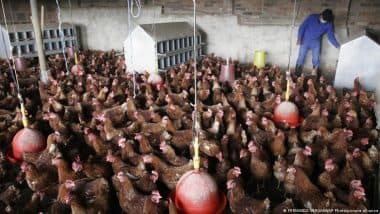A new lineage of avian flu H5N1 is ripping through wild bird populations and also affecting mammals, such as minks, badgers, pigs, bears. Are humans next?Scientists are already talking about the largest observed avian influenza epidemic in European history. And it started around the same time as COVID-19.
There are a number of different types of avian influenza that can infect birds.
Also Read | Chandrayaan-3 Moon Spacecraft Passes ISRO's Vibration Tests.
One of them is called avian flu H5N1. It first emerged in 1997 and in the past two decades has infected about 850 people. Although that's a very small number, around half of those infected have died.
A new lineage of the virus, called avian flu A (H5N1) emerged in 2020. Since then, it has ripped not only through wild bird populations, but also through specific species of mammals, such as minks, badgers, pigs and bears.
Less than ten people are documented to have become infected with this specific lineage, and at least one person has died .
Between the beginning of October 2021 and the beginning of October 2022, authorities have detected 6,615 cases in animals across 37 countries.
This year alone, since October 2022, researchers have observed a total of 2,701 cases.
Will H5N1 cause the next human pandemic?
This strain of bird flu has a 50% mortality rate and public health authorities consider that cause for concern.
The H5N1 mortality rate is higher than that of other viruses that have caused recent flu pandemics, including the 2009 H1N1 swine flu pandemic.
Researchers say that if this new lineage of H5N1 were to find a way to efficiently spread between humans, the effects could be catastrophic.
But at this point, experts say the risk of that happening is very low.
All the people who tested positive for the new avian flu lineage had had close contact with wild birds, said Richard Pebody, head of the High-threat Pathogen Team at WHO/Europe (World Health Organization).
"They have either been working on a poultry farm and involved in culling flocks or had contact with backyard flocks," Pebody said.
That suggests that if you don't have close contact with sick birds, you are safer than people who do.
How would avian influenza spread through human communities?
In order for avian flu H5N1 to spread more widely through the general public, it would have to adapt the ability to easily spread between people. And, so far, there is no evidence to indicate that this lineage of H5N1 has found a way to do that.
But researchers have expressed some concern that the virus is starting to spread among other, non-human mammals.
A massive outbreak occurred on a farm with 52,000 minks in Galicia, Spain, in October 2022. Researchers looking into that outbreak said it is possible that the virus had spread between the minks themselves.
However, the researchers said that it is difficult to identify how exactly the virus spread. They said it was hard to disentangle whether all the minks had been exposed to the virus through a source of food, for example, or whether the virus had spread among the minks — or a mix of the two possibilities.
Mammalian adaptation of H5N1 is a 'red flag'
Pebody said that proof of the virus spreading between the minks would present a "red flag […] that the virus is changing in ways which are more concerning."
"Humans are mammals as well," he added. "So, if the virus is showing some suggestion of mammalian adaptation — its ability to spread in a mammalian host — that's just one step closer to it having biological characteristics which [would] make it more attractive to spread in the human population."
Scientists are closely monitoring all large outbreaks of the virus among mammals to understand how it is spreading and evolving.
In March 2023, authorities reported an outbreak in Peru, where thousands of sea lions — up to 3% of the country's sea lion population — had died of H5N1.
Researchers are in the process of trying to identify any potential lion-to-lion spread of the virus.
Sick birds also mean rising food prices
Birds often get influenza, but the H5N1 strain has been especially deadly. Researchers estimate that over 60 million wild birds have died due to the virus or a cull in the past year.
When a single bird in a flock develops the virus, farmers are required to kill the entire flock.
And fewer farm birds mean fewer chickens in shops and at markets. The current outbreak among birds has already contributed to higher egg prices in the US and could lead higher poultry prices in general in the coming months.
How to protect yourself against avian influenza
Pebody said the best way for people to protect themselves — if they don't have to work in direct contact with birds — is to avoid picking up birds ones on the street. But the risk, said Pebody, is still low.
"It's important to highlight that there have been millions of birds that have died and we're only seeing a small number of human cases," said Pebody. "So, the risk at the moment remains relatively low. But there is a risk nonetheless."
Pebody added that people who work on poultry farms or who have chickens or hens in their backyards should wear personal protective equipment when dealing with the animals.
The WHO says that the incubation period after an infection with avian influenza A (H5N1) averages between 2 and 5 days, but it can take up to 17 days before we see symptoms.
Researchers are developing a vaccine for humans, Pebody said.
If you have had contact with dead or sick birds and develop respiratory symptoms, you should contact your doctor and local health authorities, get tested, and seek advice about antiviral treatment.
Edited by: Zulfikar Abbany
(The above story first appeared on LatestLY on Mar 16, 2023 07:50 PM IST. For more news and updates on politics, world, sports, entertainment and lifestyle, log on to our website latestly.com).













 Quickly
Quickly











